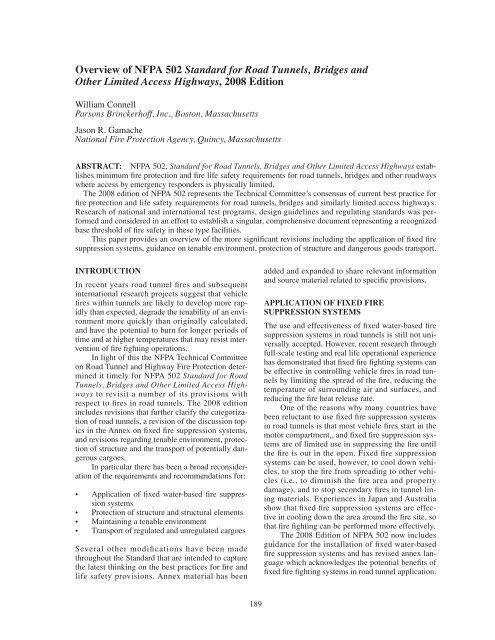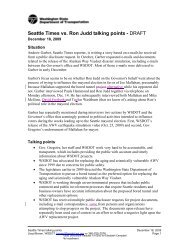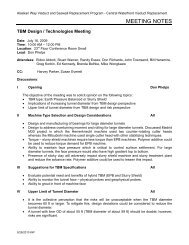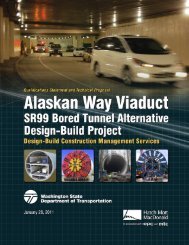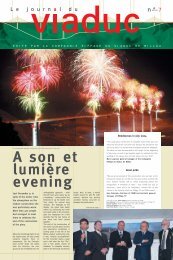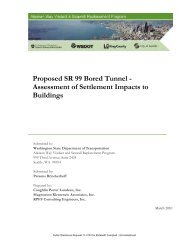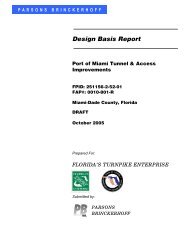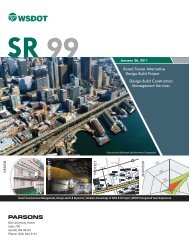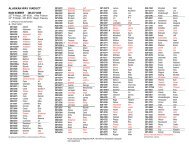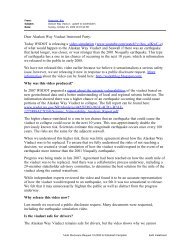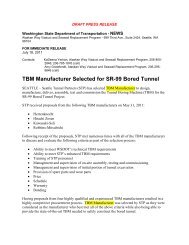Overview of NFPA 502 Standard for Road Tunnels ... - SCATnow
Overview of NFPA 502 Standard for Road Tunnels ... - SCATnow
Overview of NFPA 502 Standard for Road Tunnels ... - SCATnow
- No tags were found...
Create successful ePaper yourself
Turn your PDF publications into a flip-book with our unique Google optimized e-Paper software.
<strong>Overview</strong> <strong>of</strong> <strong>NFPA</strong> <strong>502</strong> <strong>Standard</strong> <strong>for</strong> <strong>Road</strong> <strong>Tunnels</strong>, Bridges andOther Limited Access Highways, 2008 EditionWilliam ConnellParsons Brinckerh<strong>of</strong>f, Inc., Boston, MassachusettsJason R. GamacheNational Fire Protection Agency, Quincy, MassachusettsABSTRACT: <strong>NFPA</strong> <strong>502</strong>, <strong>Standard</strong> <strong>for</strong> <strong>Road</strong> <strong>Tunnels</strong>, Bridges and Other Limited Access Highways establishesminimum fire protection and fire life safety requirements <strong>for</strong> road tunnels, bridges and other roadwayswhere access by emergency responders is physically limited.The 2008 edition <strong>of</strong> <strong>NFPA</strong> <strong>502</strong> represents the Technical Committee’s consensus <strong>of</strong> current best practice <strong>for</strong>fire protection and life safety requirements <strong>for</strong> road tunnels, bridges and similarly limited access highways.Research <strong>of</strong> national and international test programs, design guidelines and regulating standards was per<strong>for</strong>medand considered in an ef<strong>for</strong>t to establish a singular, comprehensive document representing a recognizedbase threshold <strong>of</strong> fire safety in these type facilities.This paper provides an overview <strong>of</strong> the more significant revisions including the application <strong>of</strong> fixed firesuppression systems, guidance on tenable environment, protection <strong>of</strong> structure and dangerous goods transport.INTRODUCTIONIn recent years road tunnel fires and subsequentinternational research projects suggest that vehiclefires within tunnels are likely to develop more rapidlythan expected, degrade the tenability <strong>of</strong> an environmentmore quickly than originally calculated,and have the potential to burn <strong>for</strong> longer periods <strong>of</strong>time and at higher temperatures that may resist intervention<strong>of</strong> fire fighting operations.In light <strong>of</strong> this the <strong>NFPA</strong> Technical Committeeon <strong>Road</strong> Tunnel and Highway Fire Protection determinedit timely <strong>for</strong> <strong>NFPA</strong> <strong>502</strong> <strong>Standard</strong> <strong>for</strong> <strong>Road</strong><strong>Tunnels</strong>, Bridges and Other Limited Access Highwaysto revisit a number <strong>of</strong> its provisions withrespect to fires in road tunnels. The 2008 editionincludes revisions that further clarify the categorization<strong>of</strong> road tunnels, a revision <strong>of</strong> the discussion topicsin the Annex on fixed fire suppression systems,and revisions regarding tenable environment, protection<strong>of</strong> structure and the transport <strong>of</strong> potentially dangerouscargoes.In particular there has been a broad reconsideration<strong>of</strong> the requirements and recommendations <strong>for</strong>:• Application <strong>of</strong> fixed water-based fire suppressionsystems• Protection <strong>of</strong> structure and structural elements• Maintaining a tenable environment• Transport <strong>of</strong> regulated and unregulated cargoesSeveral other modifications have been madethroughout the <strong>Standard</strong> that are intended to capturethe latest thinking on the best practices <strong>for</strong> fire andlife safety provisions. Annex material has beenadded and expanded to share relevant in<strong>for</strong>mationand source material related to specific provisions.APPLICATION OF FIXED FIRESUPPRESSION SYSTEMSThe use and effectiveness <strong>of</strong> fixed water-based firesuppression systems in road tunnels is still not universallyaccepted. However, recent research throughfull-scale testing and real life operational experiencehas demonstrated that fixed fire fighting systems canbe effective in controlling vehicle fires in road tunnelsby limiting the spread <strong>of</strong> the fire, reducing thetemperature <strong>of</strong> surrounding air and surfaces, andreducing the fire heat release rate.One <strong>of</strong> the reasons why many countries havebeen reluctant to use fixed fire suppression systemsin road tunnels is that most vehicle fires start in themotor compartment,, and fixed fire suppression systemsare <strong>of</strong> limited use in suppressing the fire untilthe fire is out in the open. Fixed fire suppressionsystems can be used, however, to cool down vehicles,to stop the fire from spreading to other vehicles(i.e., to diminish the fire area and propertydamage), and to stop secondary fires in tunnel liningmaterials. Experiences in Japan and Australiashow that fixed fire suppression systems are effectivein cooling down the area around the fire site, sothat fire fighting can be per<strong>for</strong>med more effectively.The 2008 Edition <strong>of</strong> <strong>NFPA</strong> <strong>502</strong> now includesguidance <strong>for</strong> the installation <strong>of</strong> fixed water-basedfire suppression systems and has revised annex languagewhich acknowledges the potential benefits <strong>of</strong>fixed fire fighting systems in road tunnel application.189
Specifically, Annex E now suggests the consideration<strong>of</strong> fixed fire suppression systems when it canbe shown by engineering analysis that the level <strong>of</strong>safety can be equal or exceeded by their use as part<strong>of</strong> an integrated approach to the management <strong>of</strong> lifesafety. Annex E also addresses, as follows, the previouslylisted concerns which had been expressed bytunnel designers, engineers and worldwide (authorities)regarding the application <strong>of</strong> fixed fire fightingsystem in road tunnels:Concern (1) Typically fires in road tunnelsusually occur inside vehicles or inside passengeror engine compartments designed tobe waterpro<strong>of</strong> from above; there<strong>for</strong>e, fixedfire fighting systems might not have an extinguishingeffect.It is now recognized that the purpose <strong>of</strong> afixed fire fighting fire suppression system is toprevent fire spread to other vehicles so thatthe fire does not grow to a size that cannot beattacked by the fire service.Concern (2) If any delay occurs betweenignition and fixed fire fighting system activation,a thin water spray on a very hot firecould produce large quantities <strong>of</strong> superheatedsteam without material suppressingthe fire.Fire tests have now shown this concern notto be valid. A properly design fixed fire fightingsystem suppresses the fire and cools thetunnel environment. Since a heavy goodsvehicle fire only needs 10 minutes to exceed100 MW and 1200°C, which are fatal conditions,it is important to operate the fire suppressionsystem as soon as possible.Concern (3) <strong>Tunnels</strong> are very long and narrow,<strong>of</strong>ten sloped laterally and longitudinally,vigorously ventilated, and neversubdivided, so heat normally will not belocalized over a fire.Nevertheless advances in fire detection technologyhave now made it possible to pinpointthe location <strong>of</strong> a fire in a tunnel with sufficientaccuracy to operate a zoned fixed firefighting system.Concern (4) Because <strong>of</strong> stratification <strong>of</strong> thehot gas plume along the tunnel ceiling, anumber <strong>of</strong> the activated sprinklers would not,in all probability, be located over the fire. Alarge number <strong>of</strong> the activated sprinklerswould be located away from the fire scene,producing a cooling effect that would tend todraw this stratified layer <strong>of</strong> smoke downtoward the roadway level, thus impeding therescue and fire fighting ef<strong>for</strong>t.Independent laboratories have commentedthat they do not observe smoke stratification.Any activated fixed fire fighting system, notover the fire, would cool the tunnel to helprescue services to intervene. Zoned systemsare released by a detection system that isaccurate even with <strong>for</strong>ced ventilation.Concern (5) Water spraying from the ceiling<strong>of</strong> a subaqueous tunnel could suggest tunnelfailure and induce panic in motorists.This was a theoretical concern not borne outin practice. In the event <strong>of</strong> fire motorists arelikely to recognize water spraying from nozzlesas a fire safety measure. Behavioralstudies have shown that people do not panicin a fire, even when they are unable to see.Concern (6) The use <strong>of</strong> sprinklers couldcause the delamination <strong>of</strong> the smoke layerand induce turbulence and mixing <strong>of</strong> the airand smoke, thus further threatening thesafety <strong>of</strong> persons in the tunnel.This has been shown not to be a valid concern.Fire tests have demonstrated thatsmoke does not usually <strong>for</strong>m a layer at thetop <strong>of</strong> the tunnel but quickly fills the crosssection.Normal air movement in the tunnelaccelerates this process. A fixed fire fightingfire suppression system reduces temperaturesand the risk <strong>of</strong> fire spread to other vehicles.Concern (7) Testing <strong>of</strong> a fixed fire fightingsystem on a periodic basis to determine itsstate <strong>of</strong> readiness could be impractical andcostly. Inspection can be per<strong>for</strong>med whenother facilities are inspected.A full discharge test is normally only per<strong>for</strong>medat system commissioning. Duringroutine testing the system can be configuredto discharge flow to the drainage system.PROTECTION OF STRUCTURE ANDSTRUCTURAL ELEMENTSIn the last edition (2004) <strong>NFPA</strong> <strong>502</strong> introduced newrequirements <strong>for</strong> the protection <strong>of</strong> structural elementswithin road tunnels. The 2008 edition has190
een significantly revised to provide specific guidance<strong>for</strong> the evaluation structural firepro<strong>of</strong>ingrequirements. The following requirements have beenincluded to further support road tunnel designrequirements as they pertain to both life safety andprotection <strong>of</strong> property:• Regardless <strong>of</strong> tunnel length, all primary structuralconcrete and steel elements shall be protectedin accordance with this standard inorder to:– Maintain life safety and provide a tenableenvironment.– Mitigate structural damage and prevent progressivestructural collapse.– Minimize economic impact.• The structure shall be capable <strong>of</strong> withstandingthe Rijkswaterstaat (RWS) (Netherlands) time /temperature curve, or other curve that is acceptableto the Authority Having Jurisdiction.The time/temperature development is shown inthe table below:Time(Minutes)Temp°C °F0 20 683 890 16345 1140 208410 1200 219230 1300 237260 1350 246290 1300 2372120 1200 2192• After 120-minute period <strong>of</strong> fire exposure, thefollowing failure criteria shall be satisfied:– <strong>Tunnels</strong> with cast in-situ concrete structuralelements shall be protected such that:i. The temperature <strong>of</strong> the concrete surfacedoes not exceed 380°C (716°F).ii. The temperature <strong>of</strong> the steel rein<strong>for</strong>cementwithin the concrete (assuming aminimum cover <strong>of</strong> 25mm (1 in.) does notexceed 250°C (482°F).– <strong>Tunnels</strong> with pre-cast, high-strength concreteelements shall be protected such that explosivespalling is prevented.– Steel or cast iron tunnel linings shall be protectedsuch that the lining temperature shallnot exceed 300°C (572°F).– Structural fire protection material shall benon-combustible in accordance with ASTME 136 or equal international standard.i. It shall have a minimum melting temperature<strong>of</strong> 1350°C (2462°F).ii. It shall not produce toxic smoke or fumesunder fire exposure in accordance withASTM E 84 or equal international standard.iii. It shall meet the fire protection requirementswith
MAINTAINING A TENABLEENVIRONMENTThe 2008 Edition includes a complete revision to theannex material relating to tenable environment. Thisis intended to correlate with similar guidance materialin <strong>NFPA</strong> 130, <strong>Standard</strong> on Fixed GuidewayTransit and Passenger Rail Systems. The purpose <strong>of</strong>the annex is to provide guidelines <strong>for</strong> the evaluation<strong>of</strong> tenability within the tunnel evacuation paths. Currenttechnology is capable <strong>of</strong> analyzing and evaluatingall unique conditions <strong>of</strong> each path to provideproper ventilation <strong>for</strong> pre-identified emergency conditions.The same ventilating devices might or mightnot serve both normal operating conditions and preidentifiedemergency requirements. The goals <strong>of</strong> theventilation system, in addition to addressing fire andsmoke emergencies, are to assist in the containmentand purging <strong>of</strong> hazardous gases and aerosols such asthose that could result from a chemical/biologicalrelease.Environmental conditions, geometric considerations,and time considerations should be taken intoaccount. Following are some factors that should be consideredin maintaining a tenable environment <strong>for</strong> periods<strong>of</strong> short duration.Heat EffectsExposure to heat can lead to life threat three basic ways:• Hyperthermia• Body surface burns• Respiratory tract burnsFor use in the modeling <strong>of</strong> life threat due to heat exposurein fires, it is necessary to consider only two criteria—thethreshold <strong>of</strong> burning <strong>of</strong> the skin and theexposure at which hyperthermia is sufficient to causemental deterioration and thereby threaten survival.Air Carbon Monoxide ContentAir carbon monoxide (CO) content should be as follows:• Maximum <strong>of</strong> 2000 ppm <strong>for</strong> a few seconds• Averaging 1150 ppm or less <strong>for</strong> the first 6 minutes<strong>of</strong> the exposure• Averaging 450 ppm or less <strong>for</strong> the first 15 minutes<strong>of</strong> the exposure• Averaging 225 ppm or less <strong>for</strong> the first 30 minutes<strong>of</strong> the exposure• Averaging 50 ppm or less <strong>for</strong> the remainder <strong>of</strong> theexposureThese values should be adjusted <strong>for</strong> altitudes above984 m (3000 ft).Smoke Obscuration LevelsSmoke obscuration levels should be continuouslymaintained below the point at which a sign internallyilluminated at 80 lx (7.5 ft-candles) is discernible at30 m (100 ft) and doors and walls are discernible at10 m (33 ft).Air VelocitiesAir velocities in the enclosed tramway should begreater than or equal to 0.76 m/s (150 fpm) and lessthan or equal to 11.0 m/s (2200 fpm).Noise LevelsNoise levels should be a maximum <strong>of</strong> 115 dBA <strong>for</strong> afew seconds and a maximum <strong>of</strong> 92 dBA <strong>for</strong> the remainder<strong>of</strong> the exposure.TRANSPORT OF REGULATED ANDUNREGULATED CARGOESRecent road tunnel fires suggest that goods traditionallynot characterized as ‘hazardous’; i.e. flour andmargarine (1999 Mont Blanc Tunnel), paint (1999Gothard Tunnel), and tires (2005 Frejus Tunnel),may constitute a greater risk to tunnel users and tunnelstructures than expected. As a result Chapter 13Control <strong>of</strong> Hazardous Materials has been re-titledRegulated and Unregulated Cargoes to provide guidanceto tunnel operators, first responders anden<strong>for</strong>cement <strong>of</strong>ficials on developing rules regardingany and all cargoes allowed passage through a particularroad tunnel facility.The authority having jurisdiction must adoptrules and regulations that apply to the transportation<strong>of</strong> regulated and unregulated cargoes. Design andplanning <strong>of</strong> the facility must address the potentialrisk presented by regulated and unregulated cargoes.When developing vehicle cargo regulations <strong>for</strong>a particular road tunnel facility, fire, accident, andresearch experience <strong>of</strong> the vehicles and cargo <strong>of</strong> thetype expected within the tunnel—and particularly <strong>of</strong>goods and vehicles not normally characterized ashazardous or otherwise regulated—should be considered.Some types <strong>of</strong> cargoes not normally consideredhazardous may in certain circumstances inconfined spaces within tunnels behave as, or equivalentto, hazardous materials in terms <strong>of</strong> the rate <strong>of</strong>fire growth, the intensity <strong>of</strong> the fire, discharge <strong>of</strong>noxious materials, destruction to infrastructure, andthreat to users’ safety.In developing regulations, the following mustbe addressed:1. Population density2. Type <strong>of</strong> highway3. Types and quantities <strong>of</strong> hazardous materials192
4. Emergency response capabilities5. Results <strong>of</strong> consultation with affected persons6. Exposure and other risk factors7. Terrain considerations8. Continuity <strong>of</strong> routes9. Alternative routes10. Effects on commerce11. Delays in transportation12. Climatic conditions13. Congestion and accident historySUMMARYThe 2008 Edition <strong>of</strong> <strong>NFPA</strong> <strong>502</strong> is intended to correlatethe fire and life safety provisions that arebased on the latest research, technologies, and reallifelessons learned so that tunnel designers, engineers,first responders, and operating authoritieshave an immediate source recognized requirements<strong>for</strong> creating a fire safe road tunnel environment.The <strong>NFPA</strong> <strong>502</strong> Technical Committee fullyanticipates that ongoing research programs beingconducted both nationally and internationally suchas The International <strong>Road</strong> Tunnel Fire DetectionResearch Project sponsored by The Fire ProtectionResearch Foundation, the Large-Scale Fire HeatRelease Rate Tests conducted by a variety <strong>of</strong> consortiumsin collaboration with UPTUN and the SPSwedish National Testing and Research Institute,and sprinkler system testing such as that conductedby The Netherlands Organisation <strong>for</strong> Applied ScientificResearch, will continue to yield valuable in<strong>for</strong>mation.As the Technical Committee looks <strong>for</strong>wardto the development <strong>of</strong> the 2011 Edition <strong>of</strong> <strong>NFPA</strong> <strong>502</strong>it fully recognizes that diligent attention to theresults <strong>of</strong> these research programs is necessary sothat fair evaluation and consensus <strong>of</strong> results can beexpeditiously considered <strong>for</strong> incorporation.193


